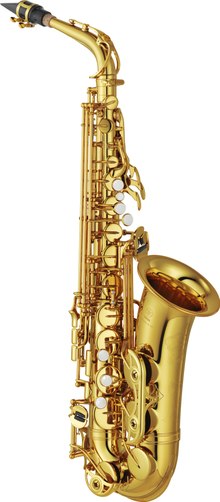
Back Saxofoon Afrikaans Saxophon ALS ሳክሶፎን Amharic ساكسفون Arabic ساكسفون ARZ Saxofón AST Saksofon Azerbaijani ساکسوفون AZB Саксафон Byelorussian Саксафон BE-X-OLD
 | |
| Woodwind instrument | |
|---|---|
| Classification | Single-reed |
| Hornbostel–Sachs classification | 422.212-71 (Single-reed aerophone with keys) |
| Inventor(s) | Adolphe Sax |
| Developed | 1840s |
| Playing range | |
 | |
| Related instruments | |
|
Sizes:
Orchestral saxophones: Specialty saxophones: | |
| Musicians | |
| See list of saxophonists | |
The saxophone (often referred to colloquially as the sax) is a type of single-reed woodwind instrument with a conical body, usually made of brass. As with all single-reed instruments, sound is produced when a reed on a mouthpiece vibrates to produce a sound wave inside the instrument's body. The pitch is controlled by opening and closing holes in the body to change the effective length of the tube.[1] The holes are closed by leather pads attached to keys operated by the player. Saxophones are made in various sizes and are almost always treated as transposing instruments. A person who plays the saxophone is called a saxophonist or saxist.[2]
The saxophone is used in a wide range of musical styles including classical music (such as concert bands, chamber music, solo repertoire, and occasionally orchestras), military bands, marching bands, jazz (such as big bands and jazz combos), and contemporary music. The saxophone is also used as a solo and melody instrument or as a member of a horn section in some styles of rock and roll and popular music.
The saxophone was invented by the Belgian instrument maker Adolphe Sax in the early 1840s[3] and was patented on 28 June 1846. Sax invented two groups of seven instruments each—one group contained instruments in C and F, and the other group contained instruments in B♭ and E♭. The B♭ and E♭ instruments soon became dominant, and most saxophones encountered today are from this series. Instruments from the series pitched in C and F never gained a foothold and constituted only a small fraction of instruments made by Sax. High-pitch (also marked "H" or "HP") saxophones tuned sharper than the (concert) A = 440 Hz standard were produced into the early twentieth century for sonic qualities suited for outdoor use, but are not playable to modern tuning and are considered obsolete. Low-pitch (also marked "L" or "LP") saxophones are equivalent in tuning to modern instruments. C soprano and C melody saxophones were produced for the casual market as parlor instruments during the early twentieth century, and saxophones in F were introduced during the late 1920s but never gained acceptance.
The modern saxophone family consists entirely of B♭ and E♭ instruments. The saxophones in widest use are the B♭ soprano, E♭ alto, B♭ tenor, and E♭ baritone. The E♭ sopranino and B♭ bass saxophone are typically used in larger saxophone choir settings, when available.
In the table below, consecutive members of each family are pitched an octave apart.
| # | B♭ family | E♭ family |
|---|---|---|
| 1 (highest) | Soprillo (piccolo) | — |
| 2 | — | Sopranino |
| 3 | Soprano | — |
| 4 | — | Alto |
| 5 | Tenor | — |
| 6 | — | Baritone |
| 7 | Bass | — |
| 8 | — | Contrabass |
| 9 (lowest) | Subcontrabass | — |
- ^ Cottrell, Stephen (2013). The Saxophone (Yale Musical Instrument Series). Yale Musical Instrument Series.
- ^ Waite, Maurice, ed. (2009). Oxford Thesaurus of English (3rd ed.). Oxford University Press. p. 49. ISBN 978-0-19-956081-3.
- ^ Raumberger, Ventzke, Claus, Karl (2001). "Saxophone". Oxford Music Online. doi:10.1093/gmo/9781561592630.article.24670. ISBN 978-1-56159-263-0. Retrieved 6 April 2019.
{{cite encyclopedia}}: CS1 maint: multiple names: authors list (link)